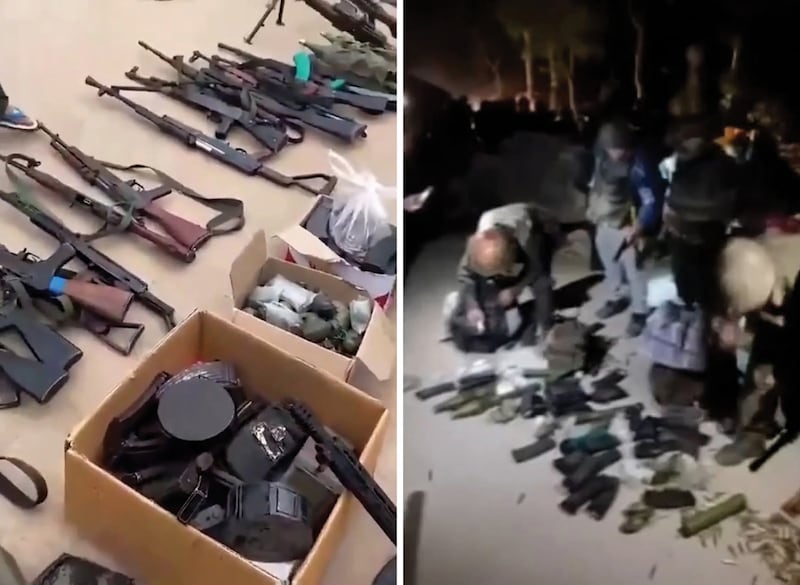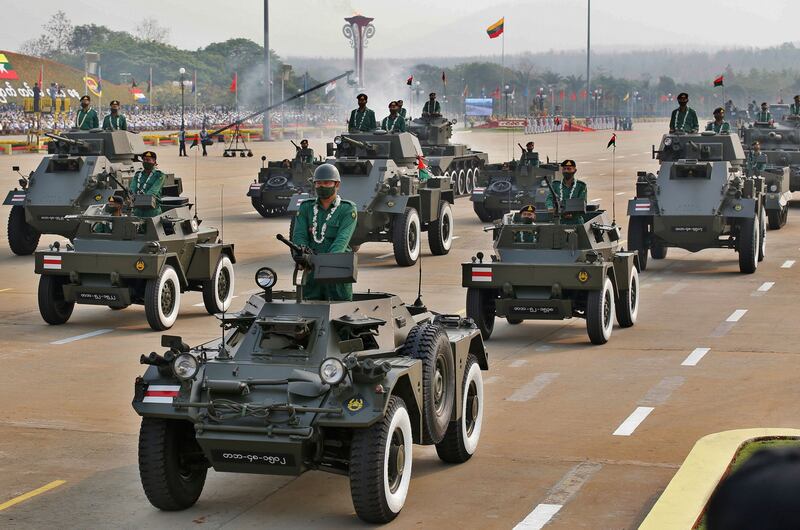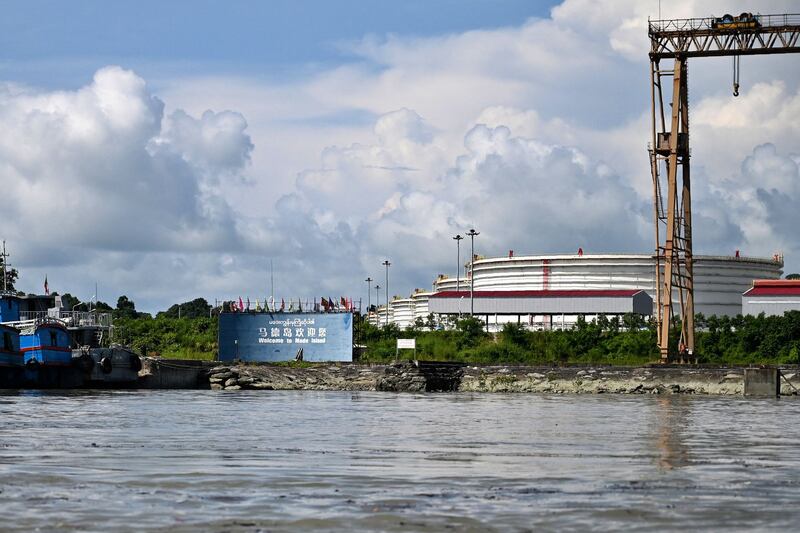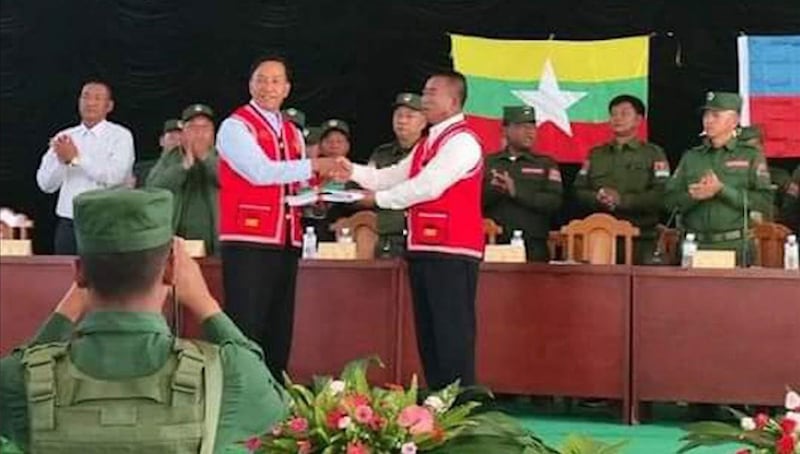With a wine toast, six Myanmar army brigadier generals negotiated the orderly withdrawal of nearly 2,400 troops and over 1,000 dependents from Laukkaing on Jan. 4, with the Myanmar National Democratic Alliance Army.
The junta submission to a member of the Three Brotherhood Alliance in Kokang Self-Administered Zone in northern Shan state was the largest surrender in the history of Myanmar’s military and the latest blow to the regime from the ethnic army trio’s 10-week-old Operation 1027.
A fellow alliance member, the Ta'ang National Liberation Army (TNLA), has continued their offensive capturing 13 towns along Highway 3.
The Arakan Army (AA), the third member of the Three Brotherhood Alliance, has continued their own offensive capturing several towns and over 100 small military encampments in Rakhine. In the latest, some 200 soldiers surrendered.
On Jan. 14, a spokesperson for the AA said it had conquered Paletwa, a port town in western Chin state that plays a vital trade and transport role with neighboring India and Bangladesh.
The fall of the river hub came six days after the AA attacked a naval base at the Chinese-invested Kyaukphyu special economic zone.

The Kachin Independence Army has joined their ally the TNLA in some assaults. They have quietly been moving in on the jade-mining center of Hpakant. Last week, they claimed to have shot down a MiG-17 helicopter.
The parallel Karenni Operation 1111 in Kayah State has seen significant gains, even though they have still not completed the liberation of the capital Loikaw.
Nonetheless, Karenni forces are getting close to fully liberating Kayah and the revolutionary state government that they established has been delivering basic human services and expanding its reach.
Signs of desperation
Since late October, over 400 military outposts have fallen to opposition hands, and with it, a large supply of weapons and ammunition.
There are several implications from the ongoing Operation 1027 offensive, named after its Oct. 27, 2022 launch date..
First, the military junta’s promised counteroffensive has not happened. The best the Tatmadaw can muster is long-range artillery and airstrikes. Indeed, a captured pilot acknowledged that the Myanmar Air Force is intentionally targeting civilians, while the commander of the 101st Light infantry Division who was captured by the TNLA acknowledged ordering war crimes against civilians.
While such tactics can sow fear, as was seen in a recent bombing in Sagaing that killed 15 people, it’s insufficient to retake territory.
Second, while there has been public criticism that the opposition National Unity Government (NUG) has been responding to events on the ground, the NUG’s planning and financing of the operation began over a year ago. Coordinated operations around the country would be extremely difficult without the shadow NUG Ministry of Defense serving as a focal point.

Third, over 4,000 troops and police have surrendered since Operation 1027 began. An entire ethnic Kachin border guard force surrendered to the KIA.
Opposition treatment of POWs has been exemplary, with no credible allegations about mistreatment or abuse. This is in stark juxtaposition to the SAC, which continues to torture and kill people taken on the battlefield, including the most recent attack in Sagaing's Kawlin.
Military manpower is clearly stretched thin. The military has abducted urban youth, fraudulently conscripting youth through false job advertisements, and dragooned men at rural checkpoints. Convicts are being released in return for enlistment.
Enter the Wa?
Likewise, retired military officers are being called up, and family members given garrison duties. The dismal state of the economy has helped recruitment into the junta's proxy Pyu Saw Htee militias.
While there is some concern that the 2,400 junta troops who surrendered on Jan. 4 were not taken as POWs, shepherded out of Kokang on the back of flatbed trucks, leaving them to be deployed elsewhere, the costs of an urban assault on the estimated 22 light infantry brigades in Laukkaing would have been too high. It also would have also resulted in even more Air Force attacks on the city.
It also reflects the lack of resources on the part of the Three Brotherhood Alliance to care for captured troops.
The troops were moved to Lashio, now the junta’s defensive perimeter. But a counter-offensive out of the city would require helicoptering in a significant amount of arms and ammunition, and their lift capacity is limited.

The military also destroyed at least one bridge into the city to prevent an assault by the Three Brotherhood Alliance.
There is hope that the humiliation of the surrender, along with their total disarmament, will cause a total breakdown of confidence in the military’s leadership.
Fourth, for the first time, the United Wa State Army (UWSA) joined Operation 1027, deposing junta forces in Hopang, in a joint operation with the MNDAA.
The powerful UWSA has been neutral since the coup, neither endorsing the NUG nor explicitly condemning the military’s seizure of power. While the well-equipped Wa army may not seek to broaden the war, or move against other Shan state groups, it is another setback for the regime.
Should the UWSA bandwagon in earnest, they are the largest ethnic resistance organization with some 30,000 troops. More importantly, they field shoulder-launched surface-to-air missiles, which could challenge the SAC’s air dominance.
Chinese concerns
Fifth, the Three Brotherhood Alliance now controls almost all towns along highways 3 and 34, to the border. Apart from Lashio, the only town that the junta controls in northern Shan State is Muse, giving the Three Brotherhood Alliance control over border trade with China, a key source of revenue.
TNLA forces captured a military camp in Nawnghkio, which is only 60 kilometers (37 miles) from Pyin Oo Lwin, home of the Defense Services Academy. Demonstrating that the regime views the town as a must-hold, the Myanmar Air Force has intensified airstrikes to drive the TNLA from Nawnghkio.
Sixth, a third Chinese-brokered ceasefire agreement, struck last week, has broken down. While the Three Brotherhood Alliance may be close to China, they have agency and have shown no willingness to accommodate Beijing because the Operation 1027 offensive is in their strategic interests.

Nonetheless, the MNDAA has been working to allay Chinese concerns by proving to be a committed partner in shutting down the internet scam centers.
Since September, some 40,000 Chinese nationals have been returned from northern Shan state, while the five families who dominated transnational crime in Laukkaing have been arrested or are on the run. China has issued arrest warrants for 10 key figures.
Despite opposition gains, there’s still reason for caution.
The offensive has come at an enormous cost to civilians. The rate of civilian casualties in November was seven times higher than the previous month. The military has responded to the capture of towns with more indiscriminate bombings and shellings and massacres of civilians.
The MNDAA estimates that over 40 civilians have died in the past six weeks in Kokang alone, while some 40 civilians were killed and 100 were wounded in one month of fighting in western Rakhine state.
Casualties , manpower woes
Moreover, casualties among opposition fighters have also been high. The capture of Namhsan in Shan state alone cost the TNLA at least 49 men, and an undisclosed number of wounded. This is not an insignificant number for a force that has 8,000 fighters at most.
The MNDAA has, likewise, taken casualties. Offensive operations will be unsustainable if the Three Brotherhood Alliance continues to take casualties at similar rates.
The high cost of the campaign has also led to allegations that the Three Brotherhood Alliance is also forcibly conscripting people.
Finally, we should never underestimate the State Administrative Council, as the junta is formally known. The current iteration of the military regime that has run Myanmar for 50 of the country’s 75 years since independence from Britain is determined and hell-bent on maintaining power.

They genuinely believe that without themselves in charge, the country will “break into pieces,” a threat that many in the international community glom onto, including neighboring Thailand and ASEAN chairman Laos.
The elite-level recriminations and infighting are happening as losses mount and the economy continues to atrophy. On Jan. 8, the SAC replaced the national security advisor and commander of the Eastern Region.
Despite reports that junta chief Min Aung Hlaing himself signed off on the withdrawal from Laukkaing, the six generals are now facing capital charges.
That will only lead to more generals turning on him, raising the question of at what point does the junta vice-chief Soe Win make his move.
Zachary Abuza is a professor at the National War College in Washington and an adjunct at Georgetown University. The views expressed here are his own and do not reflect the position of the U.S. Department of Defense, the National War College, Georgetown University or Radio Free Asia.
